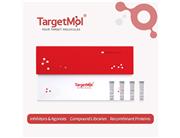| Name | Vatalanib dihydrochloride |
| Description | Vatalanib dihydrochloride (PTK787 dihydrochloride)(IC50=37 nM) is an inhibitor of VEGFR2/KDR. It exhibits less effective against VEGFR1/Flt-1 and 18-fold against VEGFR3/Flt-4. |
| Cell Research | As a test of the ability of PTK787/ZK 222584 to inhibit a functional response to VEGF, an endothelial cell proliferation assay, based on BrdUrd incorporation is used. Subconfluent HUVECs are seeded into 96-well plates coated with 1.5% gelatin and then incubated at 37 °C and 5% CO2 in growth medium. After 24 hours, growth medium is replaced by basal medium containing 1.5% FCS and a constant concentration of VEGF (50 ng/mL), bFGF (0.5 ng/mL), or FCS (5%), in the presence or absence of PTK787/ZK 222584. As a control, wells without growth factor are also included. After 24 hours of incubation, BrdUrd labeling solution is added, and cells incubated an additional 24 hours before fixation, blocking, and addition of peroxidase-labeled anti-BrdUrd antibody. Bound antibody is then detected using 3,3′5,5′-tetramethylbenzidine substrate, which results in a colored reaction product that is quantified spectrophotometrically at 450 nm. (Only for Reference) |
| Kinase Assay | VEGF Receptor Tyrosine Kinase Assays : The in vitro kinase assays are performed in 96-well plates as a filter binding assay, using the recombinant GST-fused kinase domains expressed in baculovirus and purified over glutathione-Sepharose. γ-[33P]ATP is used as the phosphate donor, and poly-(Glu:Tyr 4:1) peptide is used as the acceptor. Recombinant GST-fusion proteins are diluted in 20 mM Tris·HCl (pH 7.5) containing 1–3 mM MnCl2, 3–10 mM MgCl2, 0.25 mg/mL polyethylene glycol 20000, and 1 mM DTT, according to their specific activity. Each GST-fused kinase is incubated under optimized buffer conditions [20 mM Tris-HCl buffer (pH 7.5), 1–3 mM MnCl2, 3–10 mM MgCl2, 3–8 μg/mL poly-(Glu:Tyr 4:1), 0.25 mg/mL polyethylene glycol 20000, 8 μM ATP, 10 μM sodium vanadate, 1 mM DTT, and 0.2 μCi[γ-33P]ATP in a total volume of 30 μL in the presence or absence of a test substance for 10 minutes at ambient temperature. The reaction is stopped by adding 10 μL of 250 mM EDTA. Using a 96-well filter system, half the volume (20 μL) is transferred onto a Immobilon-polyvinylidene difluoride membrane. The membrane is then washed extensively in 0.5% H3PO4 and then soaked in ethanol. After drying, Microscint cocktail is added, and scintillation counting is performed. IC50s for PTK787/ZK 222584 or SU5416 in these as well as all assays described below are calculated by linear regression analysis of the percentage inhibition. |
| In vitro | Vatalanib inhibits Flk, c-Kit and PDGFRβ with IC50 of 270 nM, 730 nM and 580 nM, respectively. Moreover, Vatalanib shows the anti-proliferation effect by inhibiting thymidine incorporation induced by VEGF in HUVECs with and IC50 of 7.1 nM, and dose-dependently suppresses VEGF-induced survival and migration of endothelial cells in the same dose range without cytotoxic or antiproliferative effect on cells that do not express VEGF receptors. [1] A recent study shows that Vatalanib significantly inhibits the growth of hepatocellular carcinoma cells and enhances the IFN/5-FU induced apoptosis by increasing proteins levels of Bax and reduced Bcl-xL and Bcl-2. [2] |
| In vivo | Vatalanib induces dose-dependent inhibition of the angiogenic response to VEGF and PDGF in both a growth factor implant model and a tumor cell-driven angiogenesis model after once-daily oral dosing (25-100 mg/kg). Within this dose range, Vatalanib also inhibits growth and metastases of various human carcinomas in nude mice without significantly affecting circulating blood cells or bone marrow leukocytes. [1] |
| Storage | Powder: -20°C for 3 years | In solvent: -80°C for 1 year | Shipping with blue ice/Shipping at ambient temperature. |
| Solubility Information | DMSO : 79 mg/mL (188.22 mM), Sonication is recommended.
H2O : 10 mg/mL (23.82 mM), Sonication is recommended.
Ethanol : 6 mg/mL (14.29 mM), Sonication is recommended.
|
| Keywords | ZK-222584 Dihydrochloride | ZK222584 Dihydrochloride | ZK-222584 | ZK222584 | ZK 222584 Dihydrochloride | ZK 222584 | VEGFR3/FLT4 | VEGFR2/KDR | VEGFR2/Flk1 | VEGFR1/FLT1 | VEGFR | Vatalanib Dihydrochloride | Vatalanib dihydrochloride | Vatalanib (PTK787) | Vatalanib | Vascular endothelial growth factor receptor | PTK-787 Dihydrochloride | PTK787 Dihydrochloride | PTK-787 | PTK787 | PTK 787 Dihydrochloride | PTK 787 | PDGFRβ | Inhibitor | inhibit | CGP-797870 Dihydrochloride | CGP797870 Dihydrochloride | CGP-797870 | CGP797870 | CGP-79787 Dihydrochloride | CGP79787 Dihydrochloride | CGP-79787 | CGP79787 | CGP 797870 Dihydrochloride | CGP 797870 | CGP 79787 Dihydrochloride | CGP 79787 | Apoptosis |
| Inhibitors Related | Stavudine | Aceglutamide | Urea | Cysteamine hydrochloride | Sodium 4-phenylbutyrate | Metronidazole | Citric Acid Triammonium | L-Methionine | Sodium butanoate | Dimethyl phthalate | Alginic acid | Dextran sulfate sodium salt (MW 5000) |
| Related Compound Libraries | Failed Clinical Trials Compound Library | Target-Focused Phenotypic Screening Library | Bioactive Compound Library | Membrane Protein-targeted Compound Library | Kinase Inhibitor Library | Tyrosine Kinase Inhibitor Library | Anti-Cancer Clinical Compound Library | Drug Repurposing Compound Library | Inhibitor Library | Bioactive Compounds Library Max | Anti-Cancer Active Compound Library | Anti-Cancer Drug Library |

 United States
United States






